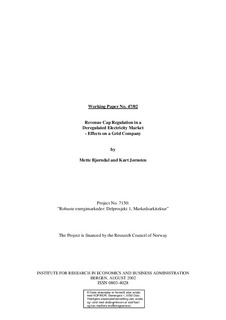| dc.description.abstract | In 1997 an incentive-based regulation was introduced for Norwegian transmission and distribution companies. Under the following revenue regulation regime, the permissible revenue of a grid company is adjusted annually, and during the first regulation period, the new revenue cap was determined on the basis of last year’s revenue cap, adjusting for inflation, productivity improvement, and load growth. The idea behind the load growth compensation factor was that the grid companies should be compensated for increased costs due to grid expansion. Load growth was chosen, partly because it was considered to be an exogenously determined variable. However, in this paper, we will examine some investment incentives due to the load growth factor of the adjustment formula of the Norwegian regulation. We will show that as a result of parallel flows in electrical networks, a seemingly reasonable regulation policy of an electricity market may have paradoxical effects. | en |
